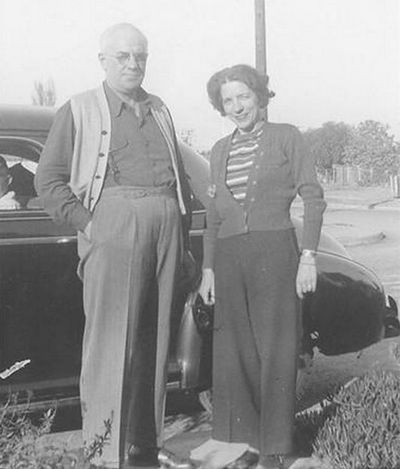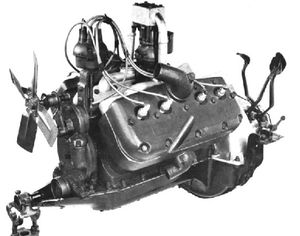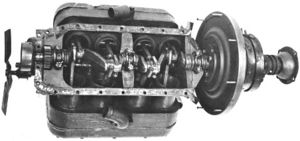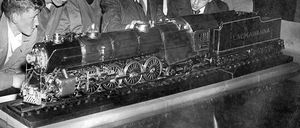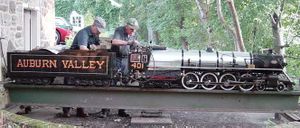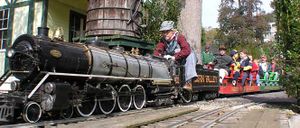Martin Lewis: Difference between revisions
No edit summary |
|||
| (5 intermediate revisions by one other user not shown) | |||
| Line 1: | Line 1: | ||
[[Category:People]] | [[Category:People]] | ||
[[File:Little-engines-martin-irene-lewis.jpg|thumb|400px|right|Martin and Irene Lewis]] | [[File:Little-engines-martin-irene-lewis.jpg|thumb|400px|right|Martin and Irene Lewis]] | ||
[[Martin Lewis]] was the founder of | [[Martin Lewis]] was the founder of an early live steam locomotive manufacturing company. | ||
== Early Life == | == Early Life == | ||
| Line 27: | Line 27: | ||
By the early 1930’s Martin had moved from San Bernardino to Wilmington, California where he began working as a mechanical engineer for Chris Craft Boats and Chrysler Marine Engines, which later became [http://www.harpursmarine.com/About.asp Harpur’s Marine Engines] ([[Bob Harpur]]'s father and uncle were the founders). It was during this time Martin met [[Irene Lewis|Irene Ott]]. They were married on June 15, 1937, and moved to Wilmington. | By the early 1930’s Martin had moved from San Bernardino to Wilmington, California where he began working as a mechanical engineer for Chris Craft Boats and Chrysler Marine Engines, which later became [http://www.harpursmarine.com/About.asp Harpur’s Marine Engines] ([[Bob Harpur]]'s father and uncle were the founders). It was during this time Martin met [[Irene Lewis|Irene Ott]]. They were married on June 15, 1937, and moved to Wilmington. | ||
=== Three Famous Northerns === | |||
[http://test.auburnheights.org/collections/trains/4-8-4-northern-engines-401-402/ From Marshall Steam Museum]: | |||
: Towards the end of the 1940s, [[Martin Lewis|Martin S. Lewis]], founder of a live steam manufacturing company in Wilmington, California, having supplied castings and drawings for smaller locomotives for many years, designed a larger scale engine, a 1½-inch scale with a track gauge of 7½-inch, and in 1956, T. Clarence Marshall began building his own 1½-inch 4-8-4 locomotive with plans and castings from [[Martin Lewis]]. By 1959, the locomotive was almost complete, and Tom and his father began planning the railroad that would circle the property, devoting hours to grading the roadbed and laying the track. On August 5, 1960, Clarence’s 75th birthday, the railroad carried its first passengers. | |||
[[ | : Several hundred people rode Engine 401 of the [[Auburn Valley Railroad]] (as it was named) during the fall of 1960. Two of the original passenger cars came from the old Tolchester Amusement Park on the Eastern Shore of Maryland (cut down from 12½-inch track gauge). Four other cars were built of similar design, and all were brightly painted in “circus train” colors. | ||
: In 1960, Historic Red Clay Valley, Inc., was incorporated, with Tom Marshall as president, and a first priority was the re-activation of steam passenger service on the Landenberg Branch of the B & O Railroad. To raise funds, Clarence Marshall agreed to “lease” the Auburn Valley Railroad to the new organization if its members would man it, and all proceeds would be turned over to HRCV. Realizing that a second train would be needed. Clarence purchased the mate to the #401 from [[Irene Lewis]], Martin’s widow, and it entered service as Engine #402 in April 1961. | |||
<gallery widths="300px" heights="300px" perrow="2"> | <gallery widths="300px" heights="300px" perrow="2"> | ||
File: | File:AuburnHeightsRR ThreeQuarterNorthern.jpg|A beautiful 4-8-4 Northern Lackawanna in 3/4 inch scale crafted from castings and drawings, this coal- or wood-fired locomotive was completed about the time Clarence’s son Tom returned home from service in World War II. | ||
File: | File:AuburnValleyRR Northern401.jpg|[[Auburn Valley Railroad]] Northern #401 built from castings. | ||
File: | File:AuburnValleyRR Northern402.jpg|[[Auburn Valley Railroad]] Northern #402 | ||
</gallery> | </gallery> | ||
=== | [http://www.chaski.org/homemachinist/viewtopic.php?f=8&t=93997&p=255384&hilit=Venezia+Martin#p255384 Jim Kreider wrote on <i>Chaski</i>]: | ||
[ | : According to [[Irene Lewis]] (who I knew quite well), the basic info for the old Northern was taken from an erecting drawing for a UP FEF-1 class Northern which showed no detail in regard to the drivers. The drivers were not a Boxpoc design but a freelance creation by [[Martin Lewis]]. | ||
: | : Martin also decided to use outside admission slide valves instead of inside admission piston valves because they were easier for a builder to fabricate instead of the spool valves with its associated circular valve liner. Martin had run into problems especially with inexperienced builders getting the piston valve liner egg shaped especially once it was pressed into the cylinder block. This would very often lead to blowby. Use of the outside admission valve gave the engine outside valve gear engines the characteristic of having the eccentric crank” lead” the main pin in forward motion rather than “follow” if the link block were left in the normal bottom position for forward motion which Martin elected to do. | ||
: | : BTW, the late [[Seymour F. Johnson|Seymour Johnson]] was the driving force behind the creation of the original Northern. | ||
: | : There was a point when one of past owners (I don’t recall who) had decided to discontinue the old Northern and thus the new Northern, using many Atlantic and Pacific parts, was created. | ||
== Death == | == Death == | ||
| Line 92: | Line 63: | ||
* [http://www.mtfca.com/discus/messages/257047/260210.html?1352364356 "Who has a V8 in their T?"] | * [http://www.mtfca.com/discus/messages/257047/260210.html?1352364356 "Who has a V8 in their T?"] | ||
* [http://www.pe.com/articles/engine-674064-ford-gentry.html "SAN BERNARDINO: City home to first Ford V-8"] | * [http://www.pe.com/articles/engine-674064-ford-gentry.html "SAN BERNARDINO: City home to first Ford V-8"] | ||
* [http://blogs.dailybreeze.com/history/2015/03/07/irene-lewis-creates-a-haven-in-lomita-for-railroad-buffs-part-1-little-engines/ "Irene Lewis creates a haven in Lomita for railroad buffs"] | |||
* [http://blogs.dailybreeze.com/history/2015/03/07/irene-lewis-creates-a-haven-in-lomita-for-railroad-buffs-part-1-little-engines/ "Irene Lewis creates a haven in Lomita for railroad buffs | |||
Latest revision as of 09:42, 12 July 2018
Martin Lewis was the founder of an early live steam locomotive manufacturing company.
Early Life
Martin Short Lewis, Jr. was born in Iowa on May 26, 1885. Early in life, Martin began a career as a mechanical engineer. He moved to Southern California in the early twentieth century and acquired a job working for J. Dale Gentry of Gentry Ford in San Bernardino, California.
Gentry-Lewis V8
Ford Motor Company introduced a V8 engine for their 1932 Model B, quite an improvement over the four-cylinder engines common at the time. This is considered Henry Ford’s last major innovation, and it put his company ahead of the competition for the next 20 years. However, Gentry had the company beat by 15 years, for it was in 1917 that he and Martin Lewis, who was active in the automobile industry in Los Angeles, joined to produce their own V8 engine. They modified the Model T four-cylinder engine using parts manufactured and assembled in San Bernardino. The engine came to be know as the Gentry-Lewis V8.
The eight-cylinder block was fitted onto the Ford Model T engine crankcase, and used the same crankshaft, camshaft and carburetor. It could be installed in a matter of hours and converted the comparatively rough running four-cylinder motor into a powerful motor of smooth performance and high efficiency. And the cost? A mere $175.
Hanford Foundry cast the block, head and manifold, and Charles Linderoth’s Machine Works at Rialto and I Streets bored the cylinders. (The foundry is now gone. However, the machine shop building still exists, but most of its tools and other equipment have been removed and it is no longer an active business. Most recently it has been known as Toman’s Machine Works.) The engines were assembled by Gentry’s expert mechanics: W. E. (Slim) Vardy, John Wallace, Johnny Kennedy, and Walter Mapstead.
Twenty or thirty engines were built over a period of about one year. When Ford representatives heard about the Gentry-Lewis engine, they came to inspect it, and were not pleased. They told Gentry that their dealers must limit activities to selling their Fords, and that he must desist from further sales of his engine, which he did. Gentry kept his first engine in storage for about 40 years before loaning it to a Gentry Ford successor, Garner-Muth Ford. Garner put it on display for a while, but it eventually was sent to the Ford Museum in Michigan.
Marriage to Irene
By the early 1930’s Martin had moved from San Bernardino to Wilmington, California where he began working as a mechanical engineer for Chris Craft Boats and Chrysler Marine Engines, which later became Harpur’s Marine Engines (Bob Harpur's father and uncle were the founders). It was during this time Martin met Irene Ott. They were married on June 15, 1937, and moved to Wilmington.
Three Famous Northerns
- Towards the end of the 1940s, Martin S. Lewis, founder of a live steam manufacturing company in Wilmington, California, having supplied castings and drawings for smaller locomotives for many years, designed a larger scale engine, a 1½-inch scale with a track gauge of 7½-inch, and in 1956, T. Clarence Marshall began building his own 1½-inch 4-8-4 locomotive with plans and castings from Martin Lewis. By 1959, the locomotive was almost complete, and Tom and his father began planning the railroad that would circle the property, devoting hours to grading the roadbed and laying the track. On August 5, 1960, Clarence’s 75th birthday, the railroad carried its first passengers.
- Several hundred people rode Engine 401 of the Auburn Valley Railroad (as it was named) during the fall of 1960. Two of the original passenger cars came from the old Tolchester Amusement Park on the Eastern Shore of Maryland (cut down from 12½-inch track gauge). Four other cars were built of similar design, and all were brightly painted in “circus train” colors.
- In 1960, Historic Red Clay Valley, Inc., was incorporated, with Tom Marshall as president, and a first priority was the re-activation of steam passenger service on the Landenberg Branch of the B & O Railroad. To raise funds, Clarence Marshall agreed to “lease” the Auburn Valley Railroad to the new organization if its members would man it, and all proceeds would be turned over to HRCV. Realizing that a second train would be needed. Clarence purchased the mate to the #401 from Irene Lewis, Martin’s widow, and it entered service as Engine #402 in April 1961.
Auburn Valley Railroad Northern #401 built from castings.
Auburn Valley Railroad Northern #402
- According to Irene Lewis (who I knew quite well), the basic info for the old Northern was taken from an erecting drawing for a UP FEF-1 class Northern which showed no detail in regard to the drivers. The drivers were not a Boxpoc design but a freelance creation by Martin Lewis.
- Martin also decided to use outside admission slide valves instead of inside admission piston valves because they were easier for a builder to fabricate instead of the spool valves with its associated circular valve liner. Martin had run into problems especially with inexperienced builders getting the piston valve liner egg shaped especially once it was pressed into the cylinder block. This would very often lead to blowby. Use of the outside admission valve gave the engine outside valve gear engines the characteristic of having the eccentric crank” lead” the main pin in forward motion rather than “follow” if the link block were left in the normal bottom position for forward motion which Martin elected to do.
- BTW, the late Seymour Johnson was the driving force behind the creation of the original Northern.
- There was a point when one of past owners (I don’t recall who) had decided to discontinue the old Northern and thus the new Northern, using many Atlantic and Pacific parts, was created.
Death
- Martin S. Lewis died May 30, 1949. His widow, Irene, carried on the business for about another 30 years.
References
- “They Tell Me”, Earl E. Buie, San Bernardino Evening Telegram, September 5, 1960
- "Who has a V8 in their T?"
- "SAN BERNARDINO: City home to first Ford V-8"
- "Irene Lewis creates a haven in Lomita for railroad buffs"
